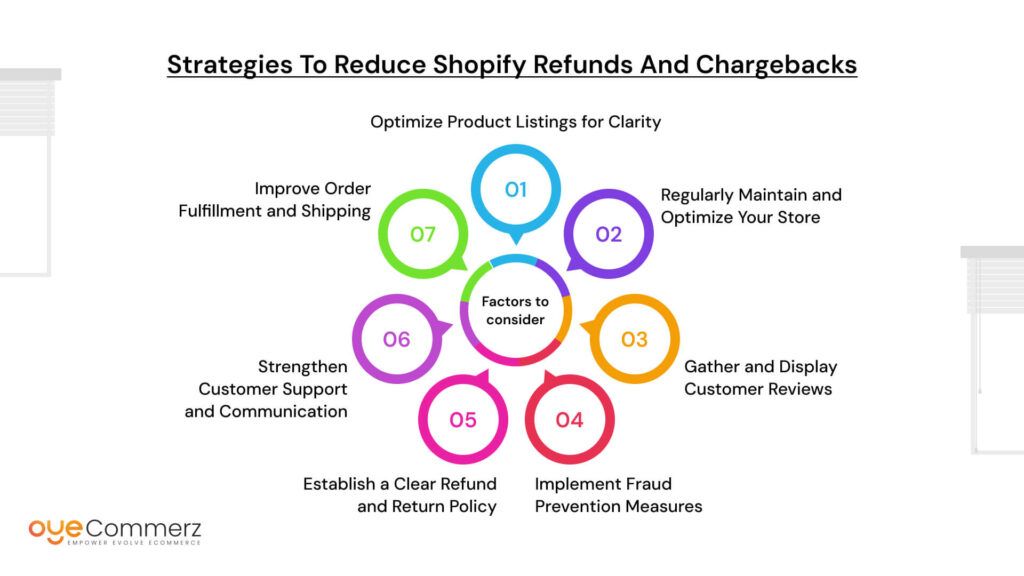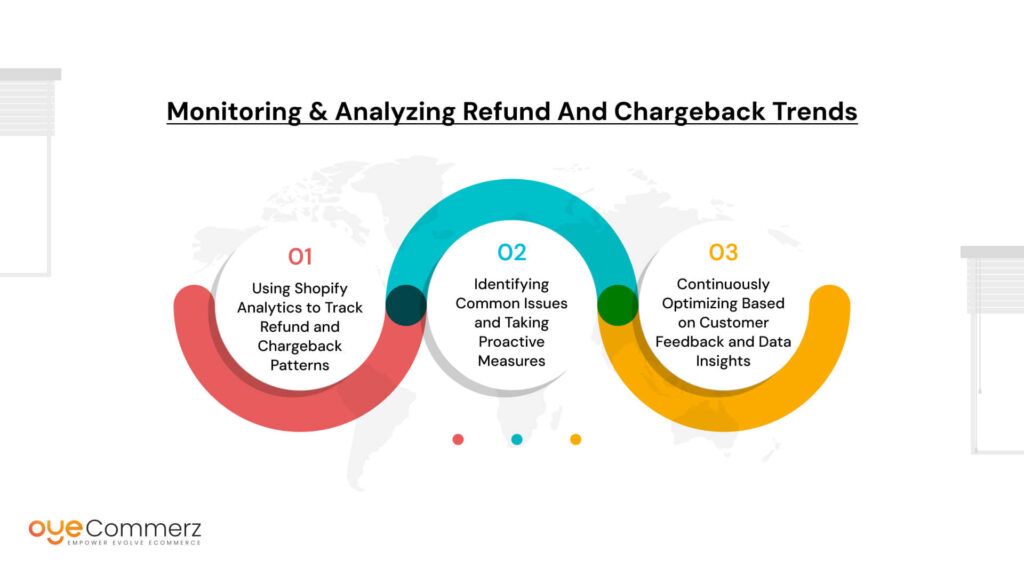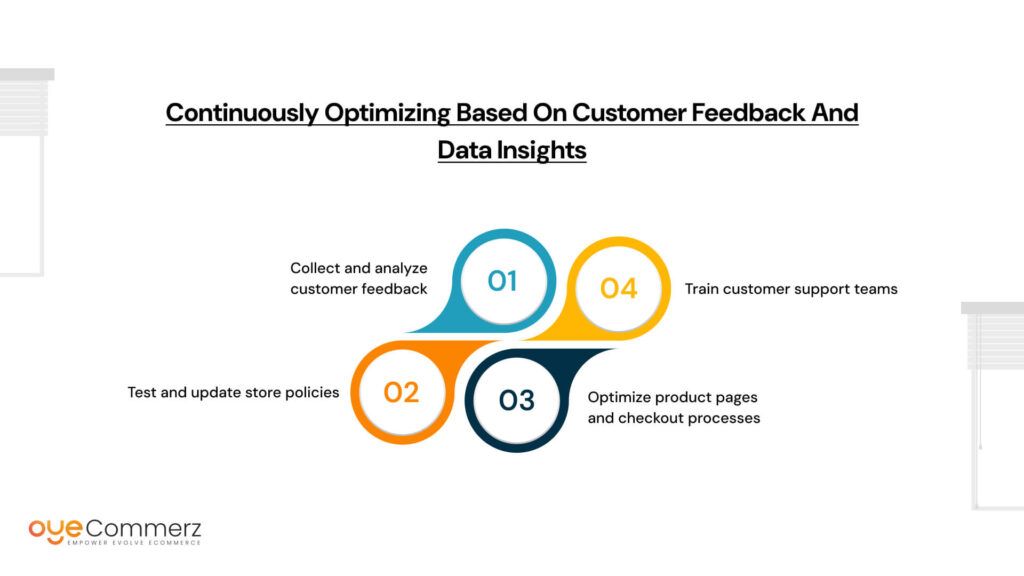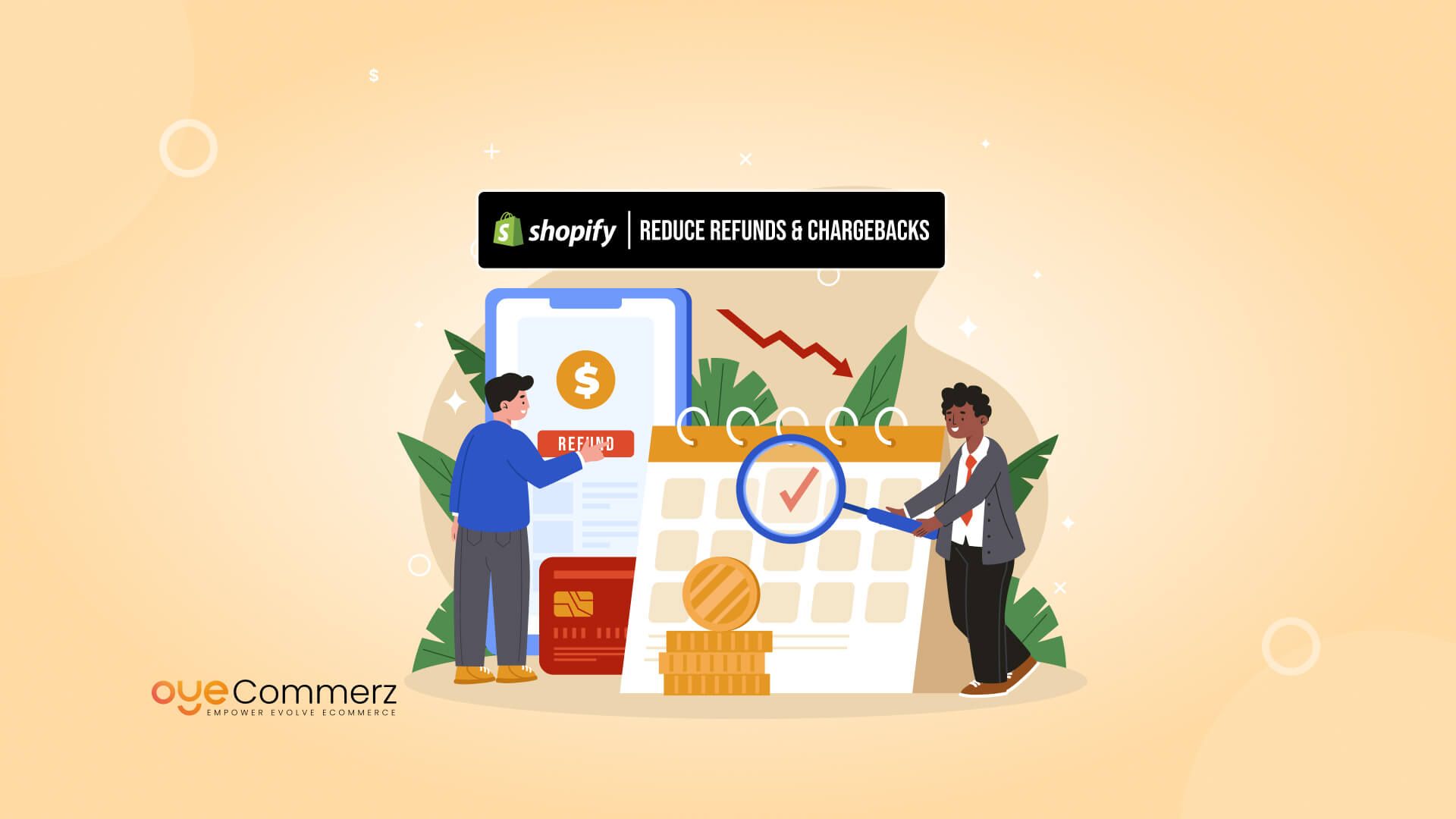Did you know that eCommerce businesses lose an average of 0.47% of their revenue to chargebacks each year? Refunds and chargebacks not only eat into your profits but can also damage your store’s reputation and lead to penalties from payment processors.
For Shopify store owners, these issues often stem from unclear product descriptions, delayed shipping, or fraudulent transactions. However, the good news is that many of these problems can be prevented with a well-maintained store. By optimizing your product listings, improving customer support, and implementing fraud prevention measures, you can reduce disputes and keep your revenue intact.
In this guide, we’ll explore practical strategies to minimize refunds and chargebacks while enhancing customer satisfaction. Let’s get started!
Table of Contents
ToggleUnderstanding Refunds and Chargebacks
Refunds and chargebacks are two of the biggest challenges for Shopify store owners, often leading to lost revenue, operational inefficiencies, and reputational damage. To effectively reduce them, it’s essential to understand what they are, why they happen, and how they impact your business.
What Are Refunds and Chargebacks?
- Refunds occur when a customer voluntarily returns a product and requests their money back. This usually happens due to dissatisfaction with the product, incorrect sizing, or shipping delays.
- Chargebacks, on the other hand, are more serious. A chargeback happens when a customer disputes a transaction with their bank or credit card provider, forcing the payment to be reversed. Chargebacks can occur due to unauthorized purchases, fraudulent activity, or dissatisfaction with the order.
Common Reasons Behind Refunds and Chargebacks
- Product Dissatisfaction – If a product does not meet customer expectations due to misleading descriptions, poor quality, or incorrect sizing, they may request a refund or dispute the charge.
- Shipping Delays – Late deliveries can frustrate customers, leading to refund requests or chargebacks due to “item not received” claims.
- Damaged or Incorrect Items – Receiving a broken or wrong item is a top reason for returns and disputes.
- Fraudulent Transactions – Fraudsters may use stolen credit cards to make purchases, leading to chargebacks when the real cardholder disputes the charge.
- Lack of Clear Refund and Return Policies – If your policies are unclear or difficult to find, customers may turn to chargebacks instead of following your return process.
- Poor Customer Support – If customers can’t get in touch with your support team regarding an issue, they may request a chargeback as their only option for resolving the problem.
The Impact on Business Revenue and Reputation
Excessive refunds and chargebacks can have serious financial and reputational consequences for Shopify store owners. Beyond the immediate loss of revenue, these issues can lead to higher costs, strained relationships with payment providers, and a decline in customer trust.
- Revenue Loss – Each refund or chargeback directly reduces your earnings, cutting into profit margins and affecting cash flow.
- Increased Processing Fees – Shopify and payment gateways impose additional fees for chargebacks, making them more expensive than standard refunds. Over time, these costs can add up and hurt profitability.
- Risk of Payment Processor Restrictions – High chargeback rates can trigger penalties from payment providers like PayPal and Stripe, leading to higher transaction fees or even account suspension, making it difficult to process future payments.
- Damage to Brand Reputation – Frequent chargebacks and refunds can result in negative customer reviews, loss of trust, and a lower conversion rate, ultimately making it harder to attract and retain customers.
By addressing the root causes of refunds and chargebacks, Shopify store owners can improve customer satisfaction, boost retention, and protect their revenue.
Strategies to Reduce Shopify Refunds and Chargebacks
Reducing refunds and chargebacks starts with proactive store management and customer transparency. Many disputes arise due to mismatched expectations, shipping issues, poor customer support, or fraudulent transactions. By optimizing product listings, improving order fulfillment, strengthening fraud prevention, and maintaining a well-functioning store, Shopify store owners can minimize chargebacks, reduce refunds, and enhance customer satisfaction.

1. Optimize Product Listings for Clarity
One of the biggest reasons for refunds is that customers receive a product that doesn’t match their expectations. To prevent this, product listings should be as detailed, clear, and visually engaging as possible.
- Use high-quality images and videos – Include multiple angles, close-up shots, lifestyle images, and even 360-degree views to give customers a complete understanding of the product.
- Write detailed and accurate descriptions – Mention essential details like material, dimensions, weight, usage instructions, and unique product features. If applicable, include allergen warnings or care instructions.
- Provide size charts and specifications – Especially for fashion and footwear, inaccurate sizing is a major reason for returns. Using clear size charts and fit recommendations can significantly reduce mismatches.
- Highlight key selling points and potential concerns – If a product runs smaller than usual or has a unique fit, inform customers upfront. Setting clear expectations reduces disappointment and unnecessary returns.
A well-informed customer is less likely to be dissatisfied with their purchase, leading to fewer refunds and chargebacks.
2. Improve Order Fulfillment and Shipping
Shipping issues including delays, lost packages, and incorrect deliveries are a leading cause of chargebacks. Customers who feel uninformed or frustrated with their delivery experience may initiate disputes.
- Offer real-time tracking and estimated delivery dates – Keeping customers informed about their order status builds trust and reduces anxiety.
- Partner with reliable shipping providers – Choose logistics partners known for timely and secure deliveries.
- Set clear expectations about shipping timelines – Be upfront about processing times, potential delays, and international shipping policies.
- Automate shipping updates via email or SMS – Regular notifications about order status and estimated delivery times keep customers engaged and reduce complaints.
By ensuring efficient and transparent shipping, businesses lower the risk of chargebacks related to undelivered or delayed items.
3. Strengthen Customer Support and Communication
Poor communication and slow response times often lead customers to file chargebacks instead of resolving issues directly with the store. A strong customer support system ensures customers receive assistance before disputes escalate.
- Implement a live chat or AI chatbot – Quick responses to common questions can prevent frustration and increase customer satisfaction.
- Provide multiple customer support channels – Offer email, phone, and social media support so customers can reach out through their preferred method.
- Automate order updates and tracking notifications – Keeping customers informed throughout their purchase journey builds trust and prevents misunderstandings.
When customers feel heard and supported, they are more likely to seek a resolution with the store directly, rather than filing a chargeback with their payment provider.
4. Establish a Clear Refund and Return Policy
An unclear or restrictive return policy can frustrate customers, leading them to file chargebacks instead of following proper return procedures. A well-defined policy ensures transparency and trust.
- Make the policy easy to find – Display return policies prominently on product pages, checkout pages, and order confirmation emails.
- Set fair return conditions while preventing abuse – Limit return windows (e.g., 30 days), require items to be in original condition, and specify eligibility criteria to protect against fraudulent claims.
- Automate the return process – Shopify apps can streamline returns, providing prepaid labels and tracking, reducing the burden on customer support.
A transparent and fair return policy encourages customers to follow proper procedures rather than resorting to disputes.
5. Implement Fraud Prevention Measures
Fraudulent transactions can lead to chargebacks that are difficult to contest. Strengthening fraud prevention protects businesses from unnecessary losses.
- Use Shopify’s built-in fraud detection tools – Shopify automatically flags high-risk orders, helping businesses prevent chargebacks.
- Enable 3D Secure authentication – This adds an extra layer of verification for credit card transactions, reducing fraud-related chargebacks.
- Require CVV codes and address verification (AVS) – These security checks ensure that transactions are authorized and reduce fraudulent orders.
By proactively identifying suspicious transactions, store owners can prevent fraud-related chargebacks before they happen.
6. Gather and Display Customer Reviews
Customer reviews help set realistic expectations, reducing post-purchase dissatisfaction. Encouraging honest feedback can improve credibility and lower refund rates.
- Encourage satisfied customers to leave reviews – Use follow-up emails or incentives to request feedback.
- Address negative reviews proactively – Respond to concerns, offer solutions, and improve products based on feedback.
- Use social proof – Display testimonials, user-generated content, and video reviews to reinforce product credibility.
Authentic reviews help potential buyers make informed purchasing decisions, reducing impulse purchases that lead to refunds.
7. Regularly Maintain and Optimize Your Store
A well-maintained Shopify store ensures a smooth shopping experience, reducing errors that could lead to chargebacks and refunds.
- Conduct frequent website audits – Check for speed, broken links, and technical issues that might cause frustration during checkout.
- Ensure mobile responsiveness – A seamless experience across devices reduces cart abandonment and accidental purchases.
- Update inventory and pricing regularly – Avoid overselling or pricing discrepancies that could result in refund requests.
Consistently optimizing the store enhances customer trust and reduces refund and chargeback requests.
Monitoring & Analyzing Refund and Chargeback Trends

Reducing refunds and chargebacks is not just about implementing preventive measures it also requires continuous monitoring and analysis. By tracking trends and identifying recurring issues, Shopify store owners can make data-driven decisions to improve their store’s performance and minimize financial losses.
Using Shopify Analytics to Track Refund and Chargeback Patterns
Shopify provides built-in analytics that can help store owners monitor key metrics related to refunds and chargebacks. Some of the most relevant reports include:
- Sales Reports – Show the total number of refunds processed and their impact on overall revenue.
- Payments and Chargeback Reports – Provide insights into chargebacks, including reasons, payment methods, and transaction history.
- Customer Behavior Reports – Help identify patterns in customer interactions that may lead to refunds or disputes.
By reviewing these reports regularly, store owners can determine if refund rates are increasing and pinpoint specific products or processes that may be causing issues.
Identifying Common Issues and Taking Proactive Measures
Once refund and chargeback patterns are identified, store owners should analyze the underlying causes and implement targeted solutions. Addressing these recurring issues can significantly reduce financial losses and improve customer satisfaction.
- High Refund Rates on Specific Products – If certain products have a consistently high refund rate, the issue may stem from inaccurate descriptions, poor quality, or sizing mismatches. Updating product pages with more detailed specifications, high-quality images, and customer reviews can help set clearer expectations and reduce returns.
- Frequent “Item Not Received” Chargebacks – Chargebacks related to missing orders often result from shipping delays or lost packages. Enhancing order fulfillment by partnering with reliable carriers, offering real-time tracking, and clearly communicating delivery timelines can minimize these disputes.
- Chargebacks Due to “Unauthorized Transactions” – A high volume of fraudulent transactions suggests weak security measures. Implementing fraud prevention tools such as Shopify’s built-in fraud analysis, enabling 3D Secure authentication, and requiring CVV codes for credit card payments can help prevent unauthorized purchases.
- Negative Customer Feedback Related to Support or Policies – If customers frequently dispute charges due to unclear refund policies or poor support, it may indicate the need for better communication and policy transparency. Ensuring that refund and return policies are easy to understand, along with improving customer service response times, can reduce frustration and prevent disputes.
Continuously Optimizing Based on Customer Feedback and Data Insights
Monitoring and analyzing refund and chargeback trends should be an ongoing process rather than a one-time effort. Store owners should regularly:

- Collect and analyze customer feedback – Use post-purchase surveys, product reviews, and direct customer interactions to understand pain points.
- Test and update store policies – Modify return and refund policies based on data insights to strike a balance between customer satisfaction and business protection.
- Optimize product pages and checkout processes – Make improvements to product descriptions, pricing transparency, and checkout security based on identified trends.
- Train customer support teams – Educate staff on common refund and chargeback reasons so they can provide better assistance and resolve issues before they turn into disputes.
By leveraging data-driven insights and making regular adjustments, Shopify store owners can create a more reliable and customer-friendly shopping experience while minimizing financial risks associated with refunds and chargebacks.
Reduce Refunds and Chargebacks with Expert Shopify Maintenance!
A well-maintained Shopify store is the key to minimizing refunds and chargebacks while maximizing customer satisfaction. Oyecommerz offers expert Shopify maintenance services, ensuring your store stays optimized, secure, and customer-friendly. From improving product listings and streamlining shipping to implementing fraud prevention, we help you create a seamless shopping experience.
Ready to protect your revenue and enhance your store’s performance? Contact Oyecommerz today for a free consultation and take the first step toward a more profitable Shopify store!
Contact to Migrate your Site to Shopify Now
Conclusion
Minimizing refunds and chargebacks on Shopify requires a proactive approach that includes optimizing product listings, improving order fulfillment, strengthening customer support, implementing fraud prevention measures, and regularly monitoring store performance. By leveraging Shopify analytics to track trends and address common issues, store owners can take data-driven actions to reduce disputes and enhance customer satisfaction. Investing in Shopify maintenance services ensures continuous store optimization, keeping policies, product details, and security measures up to date. By prioritizing a well-maintained store, businesses can build trust, improve retention, and sustain long-term profitability.




